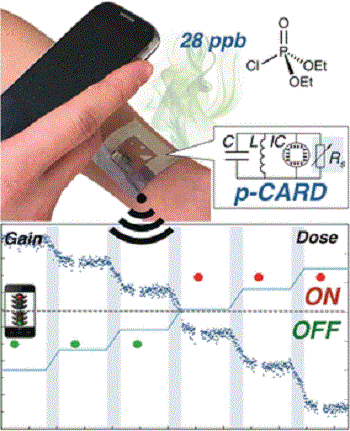Jul 12 2016
Disposable, low-cost chemidosimetric indicator with smartphone connection

The detection of exposure to chemical hazards can save lives. American scientists have developed a smart and simple chemidosimeter based on a chemiresistive sensor combined with a near-field communication tag, which can be read-out by a smartphone. This chemically actuated resonant device (CARD) is made of simple components, is disposable, ready-to-use, needs no batteries, and can be worn as a badge by people who are likely exposed to chemical hazards. It is described in the journal Angewandte Chemie.
The heart of the CARD dosimeter is a tiny chemiresistor, which makes use of single-walled carbon nanotubes to sense hazardous chemical compounds. As the chemical molecule is hydrolyzed on the surface of the nanotubes, their resistivity changes, and the more molecules are present the more pronounced is the change. As a target analyte, Rong Zhu and Joseph M. Azzarelli of the group of Timothy M. Swager at Massachusetts Institute of Technology chose cholinesterase inhibitor DCP, which is related to chemical nerve agents and thus a prototype of other gaseous substances to be detected.
The scientists obtained their CARD system by modifying standard near-field communication (NFC) tags with the chemiresistor. The NFC converts the raw chemical information from the chemiresistor into radio frequency resonance, which can be detected and read out by a nearby smartphone. As the scientists pointed out, in their improved version they rearranged the chemiresistor with regard to the integrated circuit to obtain a more linear, truly quantitative output. "The p -CARD is created by simple deposition of chemiresistive material between the leads connecting the integrated circuit," they said. This parallel electrical arrangement causes a continuous frequency-consistent and quantitative read-out for DCP.
A further significant improvement in their p-CARD concerned the carbon nanotube's detection of DCP. That was much more sensitive if ionic liquids were present, the scientists wrote. They also tested the practicablity of their system in a workday exposure to various amounts of DCP. As expected, above a certain threshold, the smartphone responded with "red light", which would tell the user that the maximum quantity was reached. That is exactly how a low-cost, sensitive, and easy-to-handle chemidosimeter badge should respond.